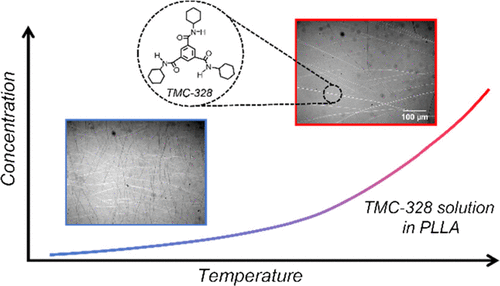当前位置:
X-MOL 学术
›
Cryst. Growth Des.
›
论文详情
Our official English website, www.x-mol.net, welcomes your feedback! (Note: you will need to create a separate account there.)
Crystallization of a Self-Assembling Nucleator in Poly(l-lactide) Melt
Crystal Growth & Design ( IF 3.8 ) Pub Date : 2021-09-01 , DOI: 10.1021/acs.cgd.1c00750 Wei Wang 1 , Angelo Saperdi 1 , Andrea Dodero 1 , Maila Castellano 1 , Alejandro J Müller 2, 3 , Xia Dong 4, 5 , Dujin Wang 4, 5 , Dario Cavallo 1
Crystal Growth & Design ( IF 3.8 ) Pub Date : 2021-09-01 , DOI: 10.1021/acs.cgd.1c00750 Wei Wang 1 , Angelo Saperdi 1 , Andrea Dodero 1 , Maila Castellano 1 , Alejandro J Müller 2, 3 , Xia Dong 4, 5 , Dujin Wang 4, 5 , Dario Cavallo 1
Affiliation

|
In the present work, crystallization of a soluble nucleator N, N′, N″-tricyclohexyl-1,3,5-benzenetricarboxylamide (TMC-328) in a poly(l-lactic acid) (PLLA) matrix has been studied at different temperatures. Based on the change in solubility with temperature, different levels of supersaturation of TMC-328 in a PLLA matrix can be obtained. This nucleator presents a fibrous structure produced via self-assembling and develops into an interconnected network when the temperature is lowered. The TMC-328 crystal nuclei density is quantified via optical microscopy, using the average distance of the adjacent fibrillar structure, which shows a steady decrease with the decrease in temperature. The crystallization rates of TMC-328 were assessed through rheological measurements of network formation. Both fibrils’ density and crystallization kinetics display a power law dependence on supersaturation. For the first time, the solid–melt interfacial energy, the size of the critical nucleus, and the number of molecules making up the critical nucleus of the nucleator TMC-328 in the PLLA matrix have been determined by adopting the classical nucleation theory. The subsequent crystallization of PLLA induced by this nucleator was investigated as a function of the fibrils’ spatial density. The crystallization rate of PLLA is enhanced with the increase in the TMC-328 fibrils’ density because of the availability of a larger nucleating surface. The self-assembled fibril of TMC-328 can serve as shish to form a hybrid shish-kebab structure after the crystallization of PLLA, regardless of the number of nucleation sites.
中文翻译:

聚(l-丙交酯)熔体中自组装成核剂的结晶
在目前的工作中,可溶性成核剂N , N ' , N '' -三环己基-1,3,5-苯三甲酰胺(TMC-328) 在聚 ( l-乳酸)(PLLA)基质已在不同温度下进行了研究。根据溶解度随温度的变化,可以获得 TMC-328 在 PLLA 基质中不同程度的过饱和度。这种成核剂呈现出通过自组装产生的纤维结构,并在温度降低时发展成相互连接的网络。TMC-328 晶核密度通过光学显微镜量化,使用相邻原纤维结构的平均距离,随着温度的降低显示出稳定的降低。TMC-328 的结晶速率通过网络形成的流变测量来评估。原纤维的密度和结晶动力学都显示出对过饱和度的幂律依赖性。第一次,固熔界面能,临界核的大小,采用经典成核理论确定了构成 PLLA 基质中成核剂 TMC-328 临界核的分子数。随后由该成核剂诱导的 PLLA 结晶被研究为原纤维空间密度的函数。由于更大的成核表面的可用性,PLLA 的结晶速率随着 TMC-328 原纤维密度的增加而提高。无论成核位点的数量如何,TMC-328 的自组装原纤维都可以作为 shish 在 PLLA 结晶后形成混合 shish-kebab 结构。随后由该成核剂诱导的 PLLA 结晶被研究为原纤维空间密度的函数。由于更大的成核表面的可用性,PLLA 的结晶速率随着 TMC-328 原纤维密度的增加而提高。无论成核位点的数量如何,TMC-328 的自组装原纤维都可以作为 shish 在 PLLA 结晶后形成混合 shish-kebab 结构。随后由该成核剂诱导的 PLLA 结晶被研究为原纤维空间密度的函数。由于更大的成核表面的可用性,PLLA 的结晶速率随着 TMC-328 原纤维密度的增加而提高。无论成核位点的数量如何,TMC-328 的自组装原纤维都可以作为 shish 在 PLLA 结晶后形成混合 shish-kebab 结构。
更新日期:2021-10-06
中文翻译:

聚(l-丙交酯)熔体中自组装成核剂的结晶
在目前的工作中,可溶性成核剂N , N ' , N '' -三环己基-1,3,5-苯三甲酰胺(TMC-328) 在聚 ( l-乳酸)(PLLA)基质已在不同温度下进行了研究。根据溶解度随温度的变化,可以获得 TMC-328 在 PLLA 基质中不同程度的过饱和度。这种成核剂呈现出通过自组装产生的纤维结构,并在温度降低时发展成相互连接的网络。TMC-328 晶核密度通过光学显微镜量化,使用相邻原纤维结构的平均距离,随着温度的降低显示出稳定的降低。TMC-328 的结晶速率通过网络形成的流变测量来评估。原纤维的密度和结晶动力学都显示出对过饱和度的幂律依赖性。第一次,固熔界面能,临界核的大小,采用经典成核理论确定了构成 PLLA 基质中成核剂 TMC-328 临界核的分子数。随后由该成核剂诱导的 PLLA 结晶被研究为原纤维空间密度的函数。由于更大的成核表面的可用性,PLLA 的结晶速率随着 TMC-328 原纤维密度的增加而提高。无论成核位点的数量如何,TMC-328 的自组装原纤维都可以作为 shish 在 PLLA 结晶后形成混合 shish-kebab 结构。随后由该成核剂诱导的 PLLA 结晶被研究为原纤维空间密度的函数。由于更大的成核表面的可用性,PLLA 的结晶速率随着 TMC-328 原纤维密度的增加而提高。无论成核位点的数量如何,TMC-328 的自组装原纤维都可以作为 shish 在 PLLA 结晶后形成混合 shish-kebab 结构。随后由该成核剂诱导的 PLLA 结晶被研究为原纤维空间密度的函数。由于更大的成核表面的可用性,PLLA 的结晶速率随着 TMC-328 原纤维密度的增加而提高。无论成核位点的数量如何,TMC-328 的自组装原纤维都可以作为 shish 在 PLLA 结晶后形成混合 shish-kebab 结构。



























 京公网安备 11010802027423号
京公网安备 11010802027423号